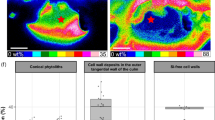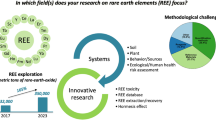Abstract
Purpose
The aim of this study was to characterize the influence of soil contamination on the trace element accumulation in nodules, inter-element relationships inside the nodules, and mobility of trace elements incorporated in nodules.
Materials and methods
We collected nodules sized 2–4 mm from pollution-free areas and areas significantly contaminated by Pb, Cd, and Zn with Dystric Cambisols on the west coast of the Pacific Ocean and studied them using a combination of advanced analytical methods and noninvasive techniques.
Results and discussion
The accumulation of trace elements by nodules was accompanied by a decrease of element mobility compared to surrounding soils. Nodules from uncontaminated soils can be highlighted as follows: (1) significant enrichment by Co and moderate enrichment by Ni, Cu, and Pb in the absence of Zn and Cd accumulation; (2) the strong affinities of Co and Cu towards Mn, association of Pb and Ni with both Mn and Fe; and (3) higher levels of Mn accumulation than in the nodules from contaminated soils. The main peculiarities of the nodules from contaminated soils were the increase in accumulation levels of Fe, Pb, Zn, and Cd, with the exception of Co; elements that were bound to Fe predominantly; and an increased trace element mobility compared to the nodules from the uncontaminated field. Nodules of two experimental fields had different composition of iron minerals.
Conclusions
Iron-Mn nodules act as barriers that limit the input of elements in soil solution. Increases in the Fe-containing compounds (both pedogenic and anthropogenic origin) in nodules enhanced the trace elements removed from the host-contaminated soils.




Similar content being viewed by others
References
Antoniadis V, Golia EE, Shaheen SM, Rinklebe J (2017) Bioavailability and health risk assessment of potentially toxic elements in Thriasio Plain, near Athens, Greece. Environ Geochem Health 39:319–330. https://doi.org/10.1007/s10653-016-9882-5
Babanin VF, Nikolaev VI, Pukhov DE, Shipilin AM, Shirmina OA (2007) Diagnostics of manganese-iron nodules in soddy-podzolic soils at different degrees of gleyzation from their magnetic properties. Eurasian Soil Sci 40(3):247–255. https://doi.org/10.1134/S1064229307030027
Cornu S, Deschatrettes V, Salvador-Blanes S, Clozul B, Hardy M, Branchut S, Forestier LL (2005) Trace element accumulation in Mn-Fe-oxide nodules of a planasolic horizon. Geoderma 125:11–24. https://doi.org/10.1016/j.geoderma.2004.06.009
Cornu S, Cattle JA, Samouelian A, Laveuf C, Guilherme LRG, Alberic P (2009) Impact of redox cyclers on manganese, iron, cobalt, and lead in nodules. Soil Sci Soc Am J 73:1231–1241. https://doi.org/10.2136/sssaj2008.0024
Ettler V, Chren M, Mihaljevic M, Drahota P, Kribek B, Veselovsky F, Sracek O, Vanek A, Penizek V, Komarek M, Mapani B, Kamona F (2017) Characterization of Fe-Mn concentric nodules from Luvisol irrigated by mine water in a semi-arid agricultural area. Geoderma 299:32–42. https://doi.org/10.1016/j.geoderma.2017.03.022
Feng J-L (2011) Trace elements in ferromanganese concretions, gibbsite spots, and the surrounding terra rossa overlying dolomite: their mobilization, redistribution and fractionation. J Geochem Explor 108:99–111. https://doi.org/10.1016/j.gexplo.2010.10.010
Gasparatos D (2012) Fe-Mn concretions and nodules to sequester heavy metals in soils. In: Lichtfouse E, Schwarzbauer J, Robert D (eds) Environmental chemistry for a sustainable world, volume 2: remediation of air and water pollution. Springer, Berlin, pp 443–474
Gasparatos D (2013) Sequestration of heavy metals from soil with Fe-Mn concretions and nodules. Environ Chem Letter 11:1–9. https://doi.org/10.1007/s10311-012-0386-y
Gasparatos D, Massas I, Godelitsas A (2019) Fe-Mn concretions and nodules formation in redoximorphic soils and their role on soil phosphorus dynamics: current knowledge and gaps. Catena 182:104106. https://doi.org/10.1016/j.catena.2019.104106
Hu XF, Su Y, Ye R, Li XQ, Zhang GL (2007) Magnetic properties of the urban soils in Shanghai and their environment implications. Catena 70:428–436. https://doi.org/10.1016/j.catena.2006.11.010
Islam MS, Ahmed MK, Raknuzzaman M, Al-Mamun MH, Islam MK (2015) Heavy metal pollution in surface water and sediment: a preliminary assessment of an urban river in a developing country. Ecol Indic 48:282–291. https://doi.org/10.1016/j.ecolind.2014.08.016
Jien S-H, Z-Ye H, Chen Z-S (2010) Hydropedological implications of ferromanganiferous nodules in rice-growing plinthitic Ultisols under different moisture regimes. Soil Sci Soc Am J 74:880–891. https://doi.org/10.2136/sssaj2009.0020
Jordanova N (2016) Soil magnetism: applications in pedology, environmental science and agriculture. Academic Press, San Diego
Kabata-Pendias A (2011) Trace elements in soils and plants, 4rd edn. CRC Press, NY
Kachur AN, Arzhanova VS, Yelpatyevsky PV, von Braun MC, von Lindern IH (2003) Environmental conditions in the Rudnaya River watershed a compilation of Soviet and post-Soviet era sampling around a lead smelter in the Russian Far East. Sci Total Environ 303(1–2):171–185. https://doi.org/10.1016/S0048-9697(02)00351-0
Liu F, Colombo C, Adamo P, He JZ, Violante A (2002) Trace elements in manganese-iron nodules from a Chinese Alfisol. Soil Sci Soc Am J 66:661–670. https://doi.org/10.2136/sssaj2002.6610
Lohr SC, Grigorescu M, Cox ME (2013) Iron nodules in ferric soils of the Fraser Coast, Australia: relicts of laterisation or features of contemporary weathering and pedogenesis? Soil Research 51(2):77–93
Luo W, Lu Y, Gisey J, Wang T, Shi Y, Wang G, Xing Y (2007) Effects of land use on concentrations of metals in surface soils and ecological risk around Guanting Reservoir, China. Environ Geochem Health 29:459–471. https://doi.org/10.1007/s10653-007-9115-z
Manceau A, Tamura N, Celestre R, Macdowell A, Geoffery N, Sposito G, Padmore HA (2003) Molecular-scale speciation of Zn and Ni in soil ferromanganese nodules from loess soils of the Mississippi Basin. Environ Sci Technol 37:75–80. https://doi.org/10.1021/es025748r
Meena NK, Maitib S, Shrivastava A (2011) Discrimination between anthropogenic (pollution) and lithogenic magnetic fraction in urban soils (Delhi, India) using envirionmental magnetism. J Appl Geophis 73:121–129. https://doi.org/10.1016/j.jappgeo.2010.12.003
Negra C, Ross DS, Lanzirotti A (2005) Soil manganese oxides and trace metals: competitive sorption and microfocused synchrotron X-ray fluorescence mapping. Soil Sci Soc Am J 69:353–361. https://doi.org/10.2136/sssaj2005.0353
Palumbo B, Bellanca A, Neri R, Roe MJ (2001) Trace metal partitioning in Fe–Mn nodules from Sicilian soils, Italy. Chem Geol 173:257–269. https://doi.org/10.1016/S0009-2541(00)00284-9
Pansu M, Gautheyrou J (2006) Handbook of soil analysis mineralogical, organic and inorganic methods. Springer-Verlag, Berlin
Segvic B, Girardclos S, Zanoni G, Arbiol Gonzalez C, Steimer-Herbet T, Besse M (2018) Origin and paleoenvironmental significance of Fe-Mn nodules in the Holocene perialpine sediments of Geneva Basin, western Switzerland. Appl Clay Sci 160:22–39. https://doi.org/10.1016/j.clay.2018.01.027
Simon E, Harangi S, Baranyai E, Braun M, Fabian I, Mizser S (2016) Distribution of toxic elements between biotic and abiotic components of terrestrial ecosystem along an urbanization gradient: soil, leaf litter and ground beetles. Ecol Indic 60:258–264. https://doi.org/10.1016/j.ecolind.2015.06.045
Sipos P, Nemeth T, May Z, Szalai Z (2011) Accumulation of trace elements in Fe-rich nodules in neutral-slightly alkaline floodplain soil. Carp J Earth Environ Sci 6(1):13–22
Suda A, Makino T (2016) Functional effects of manganese and iron oxides on the dynamics of trace elements in soils with a special focus on arsenic and cadmium: a review. Geoderma 270:68–75. https://doi.org/10.1016/j.geoderma.2015.12.017
Szymanski W, Skiba M, Blachowski A (2014) Mineralogy of Fe-Mn nodules in Albeluvisols in the Carpathian Foothills, Poland. Geoderma 217–218:102–110. https://doi.org/10.1016/j.geoderma.2013.11.008
Tan WF, Liu F, Li YH, Hu HQ, Huang QY (2006) Elemental composition and geochemical characteristics of iron-manganese nodules in main soils of China. Pedosphere 16:72–81. https://doi.org/10.1016/S1002-0160(06)60028-3
Timofeeva YO (2008) Accumulation and fractionation of trace elements in soil ferromanganese nodules of different size. Geochem Int 46(3):260–267. https://doi.org/10.1134/S0016702908030038
Timofeeva YO, Golov VI (2007) Sorption of heavy metals by iron-manganic nodules in soils of Primorskii region. Eurasian Soil Sci 40(12):1308–1315. https://doi.org/10.1134/S1064229307120071
Timofeeva YO, Karabtsov AA, Semal VA, Burdukovskii ML, Bondarchuk NV (2014) Iron-manganese nodules in Udepts: the dependence of the accumulation of trace elements on nodule size. Soil Sci Soc Am J 78:767–778. https://doi.org/10.2136/sssaj2013.10.0444
Timofeeva YO, Yu K, Semal V, Burdukovskii M (2018) Origin, baseline contents and vertical distribution of selected trace lithophile elements in soils from nature reserves, Russian Far East. J Soils Sediments 18:968–982. https://doi.org/10.1007/s11368-017-1847-5
Vodyanitskii YN (2010) Iron hydroxides in soils: a review of publications. Eurasian Soil Sci 43(11):1244–1254. https://doi.org/10.1134/S1064229310110074
Vodyanitskii YN (2013) Biogeochemical role of magnetite in urban soils (review of publications). Eurasian Soil Sci 46(3):317–324. https://doi.org/10.1134/S1064229313030137
Vodyanitskii YN, Sivtsov AV (2004) Formation of ferrihydrite, ferroxyhyte, and vernadite in soil. Eurasian Soil Sci 37(8):863–875
Vodyanitskii YN, Lesovaya SN, Sivtsov AV (2003) Iron hydroxidogenesis in forest and steppe soils of the Russian Plain. Eurasian Soil Sci 36(4):420–429
Vodyanitskii YN, Morgun EG, Rumyantseva KA, Obydenova LA, Chapygina NV (2009) Geochemistry of magnetite and maghemite in soils in European Russia. Geochem Int 47(3):297–310. https://doi.org/10.1134/S0016702909030070
Vodyanitskiy YN (2005) Manganese oxides in soils. V.V. Dokuchaev Soil Sci. Inst. of RAAS Press, Moscow (in Russian)
von Braun MC, von Lindern IH, Khristoforova NK, Kachur AN, Yelpatyevsky PV, Elpatyevskya VP, Spalinger SM (2002) Environmental lead contamination in the Rudnaya Pristan Dalnegorsk mining and Smelter District, Russian Far East. Environ Res 88–A:164–173. https://doi.org/10.1006/enrs.2002.4329
World Reference Base for Soil Resources 2006 - A framework for international classification, correlation and communication. Intern. World Soil Resources Reports 103, FAO, Rome
Yousaf B, Amina LG, Wang R, Imtiaz M, Rizwan MS, Zia-ur-Rehman M, Si Y (2016) The importance of evaluating metal exposure and predicting human health risks in urban–periurban environments influenced by emerging industry. Chemosphere 150:79–89. https://doi.org/10.1016/j.chemosphere.2016.02.007
Acknowledgments
The analyses described in this work were performed using equipment from the Instrumental Center for Biotechnology and Gene Engineering at the Federal Scientific Center of the East Asia Terrestrial Biodiversity FEB RAS and the Primorye Analytical Center for Local Element and Isotope Analysis at the Far Eastern Geological Institute.
Availability of data and material (data transparency)
This article contains data and materials which support their published claims and comply with field standards.
Code availability (software application or custom code)
Not applicable.
Funding
This study was done with the financial support from the Ministry of Education and Science of Russian Federation (project 0267-2019-0016) and the program for fundamental research “The Far East” (project 18-4-049).
Author information
Authors and Affiliations
Contributions
All authors contributed to the conception of the work. Material sampling and analysis were performed by Yana Timofeeva, Alexander Karabtsov, Maria Ushkova, Maxim Burdukovskii, and Victoria Semal. The first draft of the manuscript was written by Yana Timofeeva, and all authors commented on previous versions of the manuscript. All authors read and approved the final manuscript.
Corresponding author
Ethics declarations
Conflict of interest
The authors declare that they have no conflict of interest.
Ethics approval
This article does not contain any studies with human participants or animals performed by any of the authors.
Consent to participate
Not applicable.
Consent for publication
Not applicable.
Additional information
Responsible editor: Dong-Mei Zhou
Publisher’s note
Springer Nature remains neutral with regard to jurisdictional claims in published maps and institutional affiliations.
Rights and permissions
About this article
Cite this article
Timofeeva, Y.O., Karabtsov, A., Ushkova, M. et al. Variation of trace element accumulation by iron-manganese nodules from Dystric Cambisols with and without contamination. J Soils Sediments 21, 1064–1078 (2021). https://doi.org/10.1007/s11368-020-02814-w
Received:
Accepted:
Published:
Issue Date:
DOI: https://doi.org/10.1007/s11368-020-02814-w




